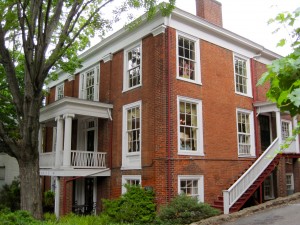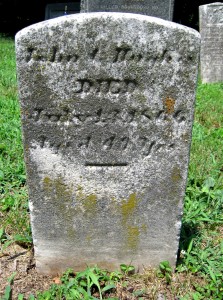John C. Hughes, born in 1817, was from Charlottesville. In the summer of 1840, Hughes became a graduate of and the valedictory speaker at the Botanico-Medical College of Ohio which had been established in 1839 by Alva Curtis who had broken away from strict Thomsonianism, a system which opposed the regular or allopathic medical treatment of the day.1 Seen as a possible future professor in the Botanico-Medical College, the editor of the Botanico-Medical Recorder wanted to “keep an eye upon him” and requested that Hughes report his progress. When he did this only once, further inquiry was made, and it was discovered that he had slowly returned to the “old system of bloodshed and poison.”2. In fact, he had attended the 1843-1844 session at the University of Virginia, taking Chemistry, Medicine, and Anatomy & Surgery. Of the 41 students in that session who studied medicine, he was one of eleven who earned the Doctor of Medicine degree.3
For a botanic practitioner, especially one who was so promising, to turn to regular medicine was particularly galling. This was made perfectly clear in the Recorder which in referring to Dr. H. stated, “he who abandoned truth for error, and the art of healing for the practice of killing, has lost his business if not his character …, and must repent and do his first works or turn to his farm or his merchandize or starve.”4
Hughes had been in a medical partnership with another future fee bill signer, Dr. James Poindexter, but indicated that his partnership had been dissolved by 1845. He met the attack of the Recorder on his own use of regular medicine by claiming that Dr. Poindexter had actually combined the regular and botanical systems himself. Dr. Hughes wrote that he “retired from the field in order to give his attention to studies, as connected with a course of lectures upon ‘medicine and its collateral branches,’ in the University of Virginia.”5

Jno. C. Hughes signed as a non-resident student on October 6, 1843, that he had carefully read the laws of the University. University of Virginia Matriculation Books, 1825-1904, (RG-14/4/2.041), 138. Courtesy of Special Collections, University of Virginia Library.
In 1850 his residence included his wife of two years, Ann Timberlake Hughes, and one son a year old.6 He owned five slaves.7 Dr. Hughes built a doctor’s office and a “fine brick residence” in the Greek Revival style around 1853-1854 in downtown Charlottesville at 307 East Market Street, home in 2012 of the Second Yard. He welcomed two daughters about this time, one in 1854 and one in 1855.8 Dr. Hughes wrote a letter in 1853 to the Governor of Virginia in which he stated that he was not the usual physician of the Mosby family (apparently his former partner, Dr. Poindexter, held that position), but had seen family members professionally and had “serious apprehension of his [John S. Mosby’s] premature death with Tubercular Consumption“ if he had to serve his entire jail term for shooting George Turpin. He asked the Governor to “relax the punishment.”9
Dr. Hughes hosted a social meeting with Alexander Campbell, a leader of a Christian revival movement in the United States associated with the Second Great Awakening. Campbell made more than one trip to Virginia, but the trip that included a visit to Hughes was probably in 1855.10 In addition to his medical work Hughes was a trustee for the John LeTellier carriage shop and announced in 1860 that this business would close.11 Dr. Hughes died in 1866 at the age of 49 leaving a considerable estate of $16,302 and a wife who outlived him for thirty years.12
- “A letter from a friend in Va.,” Botanico-Medical Recorder 13, no. 6 (1845): 98. [↩]
- “Dr. John C. Hughes,” Botanico-Medical Recorder 13, no. 12 (April 26 1845): 195 [↩]
- University of Virginia, Catalogue of the Officers and Students of the University of Virginia (1843-1844). [↩]
- “A letter from a friend in Va.,” Botanico-Medical Recorder 13, no. 6 (1845): 98. [↩]
- “Dr. John C. Hughes,” Botanico-Medical Recorder 13, no. 12 (April 26 1845): 196. [↩]
- U.S. Census: Albemarle, Virginia, 1850, accessed 29 March 2011. [↩]
- Slave Schedule, 1850, Federal Census, Albemarle, Virginia (Charlottesville), accessed 23 March 2011. [↩]
- James Alexander, Early Charlottesville: Recollections of James Alexander, 1828-1874, reprinted from the Jeffersonian Republican by the Albemarle County Historical Society, edited by Mary Rawlings, 1963 notes and revisions by Velora Carver Thomson ([Charlottesville, Va.: The Michie Co., Printers], 1963): 58; James Cabell Dabney, “Memoirs of James Cabell Dabney (1875-1961),” annotated by Mary Hosmer Lupton, The Magazine of Albemarle County History 48 (1990): 63; Maplewood Cemetery, Charlottesville, grave marker for Sarah and Ellie Hughes. [↩]
- William M.E. Rachal, “Petitions Concerning the Pardon of John S. Mosby in 1853,” Papers of the Albemarle County Historical Society 9 (1948-1949): 24; Dabney, 63. [↩]
- C[ampbell], A[lexander], “Notes on a Tour to Eastern Virginia No. 2,” The Millennial Harbinger, 4th ser., vol. 6 (1856): 136, accessed 29 June 2011; Biographical Sketch on the Life of Alexander Campbell, accessed 29 June 2011. [↩]
- Newton Bond Jones, Charlottesville and Albemarle County, Virginia 1819-1860, A Dissertation Presented to the Graduate Faculty of the University of Virginia in Candidacy for the Degree of Doctor of Philosophy (1950), 194-195. [↩]
- Department of Community Development, Charlottesville, Virginia, Historic Landmark Study, Prepared for Landmarks Commission ([Charlottesville, Va.: Michie Co.], 1976), 27. Mrs. Gordon Harris and Mrs. J.E. Early, Jr., Record of Cemeteries in Albemarle County, Virginia, Including Charlottesville, vol. 9 ([Charlottesville]: Jack Jouett Chapter, NSDAR, 1975), 179. [↩]



